Must Reads: As âAdventure Timeâ wraps, a look back at how the series broke barriers and changed the genre
In 2010, a new cartoon debuted with these bold lines.
"Princess Bubblegum," asks Finn, a human boy, âwhen we bring the dead back to life, will they be filled with worms?"
"No," Princess Bubblegum replies. "If my Decorpsinator serum works, then all the dead candy people will look as young and healthy as you do."
It doesnât quite work out for the dead â candy zombies wreck a slumber party in the first episode of âAdventure Timeâ â but for the living, Pendleton Wardâs animated epic becomes a cultural phenomenon. Its 10-season run on Cartoon Network comes to a close Sept. 3 in an hourlong finale, having filled Comic-Con convention halls, inspired innumerable cosplayers and fan artists and picked up rave reviews, multiple Emmys, a Peabody Award and a Macyâs float along the way. Its characters have been modeled for sale in plush and plastic and pixels, as LEGO pieces and video game avatars.
Finn (Jeremy Shada) and his shape-shifting dog (John diMaggio) began the series as romping adventurers, fighting monsters on a generally charming if often dangerous mutant Earth, about a thousand years after the apocalyptic Mushroom War. The Land of Ooo is where they live, with its Candy Kingdom, Ice Kingdom, Flame Kingdom, Nightosphere and Lumpy Space, each with its issues, its creatures, its customs, its king or princess.
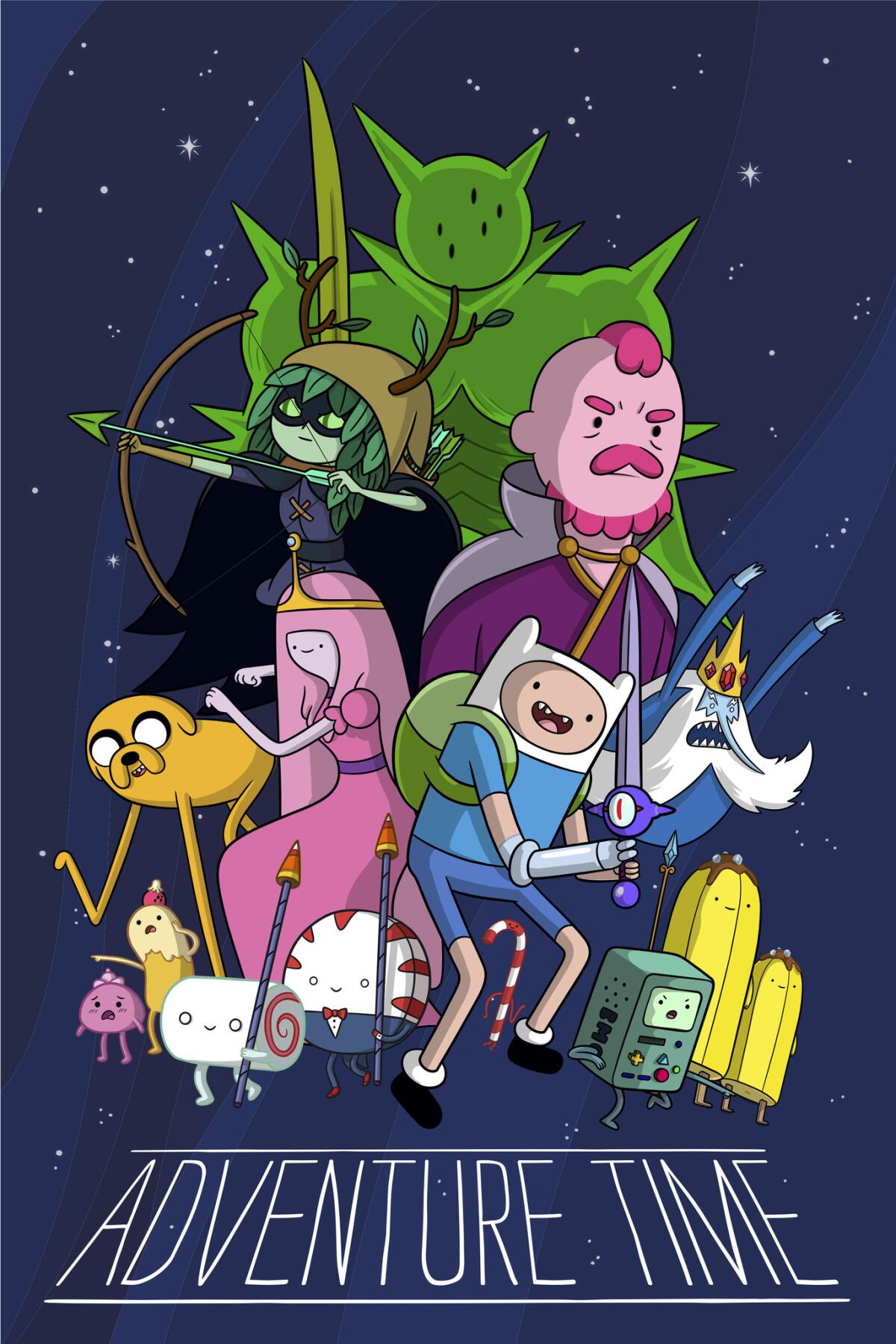
The series developed over time, from a story of sword-swinging amateur heroics into one more concerned with family and friends and affections; it is spiritual in a way that doesnât deny the power of broken wind. The comical bumps up against the chaotic, the domestic beats back the dreadful. âAdventure Timeâ is cosmically cosmopolitan: Many things are alive and all imaginable things are potentially welcome â notwithstanding that the tale has brought Ooo to the brink of civil war. Itâll make you laugh and break your heart.
Below, some of the many people who made it â several of whom have gone on to create beloved, award-winning cartoons of their own â remember some of what it was like.
Pen Ward begins cartooning as a boy growing up in San Antonio, Texas.
Pen Ward (creator): Have you ever developed a photograph? That first time and youâre like âMagic is real!â Thatâs what animation feels like when you first make a character just blink. Just making the eyes squeeze down into little thin lines and then back up into little dots. And youâre like, âWow itâs alive!â I was interested in animation from a really early age. I was doing flip books in first grade on Post-it notes. My mother, who is an artist, would keep Post-it notes in her purse to keep me busy 'cause she was a single mom with three boys and I would just go with her everywhere.
Adventure Time is born as âa doodleâ in Valencia at Cal Arts, where Pen Ward is a student alongside future key collaborators Adam Muto and Pat McHale.
Ward: Cal Arts had a lot of pretty typical drunken-college-kid party stuff going on, but animators would always just hole up inside of their cubicles and work.
Pat McHale (creative director, later creator of âOver the Garden Wallâ): The teachers were great, but being around other people who are super talented, who are also working towards the same kind of thing, gets you excited and, like, âIâm terrible, but I want to be better.â
Ward: It was just a sketch I kicked out into a minute-long short, where Finn and Jake save Princess Bubblegum from the Ice King using rocket boots. Nickelodeon was taking pitches from Cal Arts students. And they didnât like it -- my drawings were baaaaad in school.
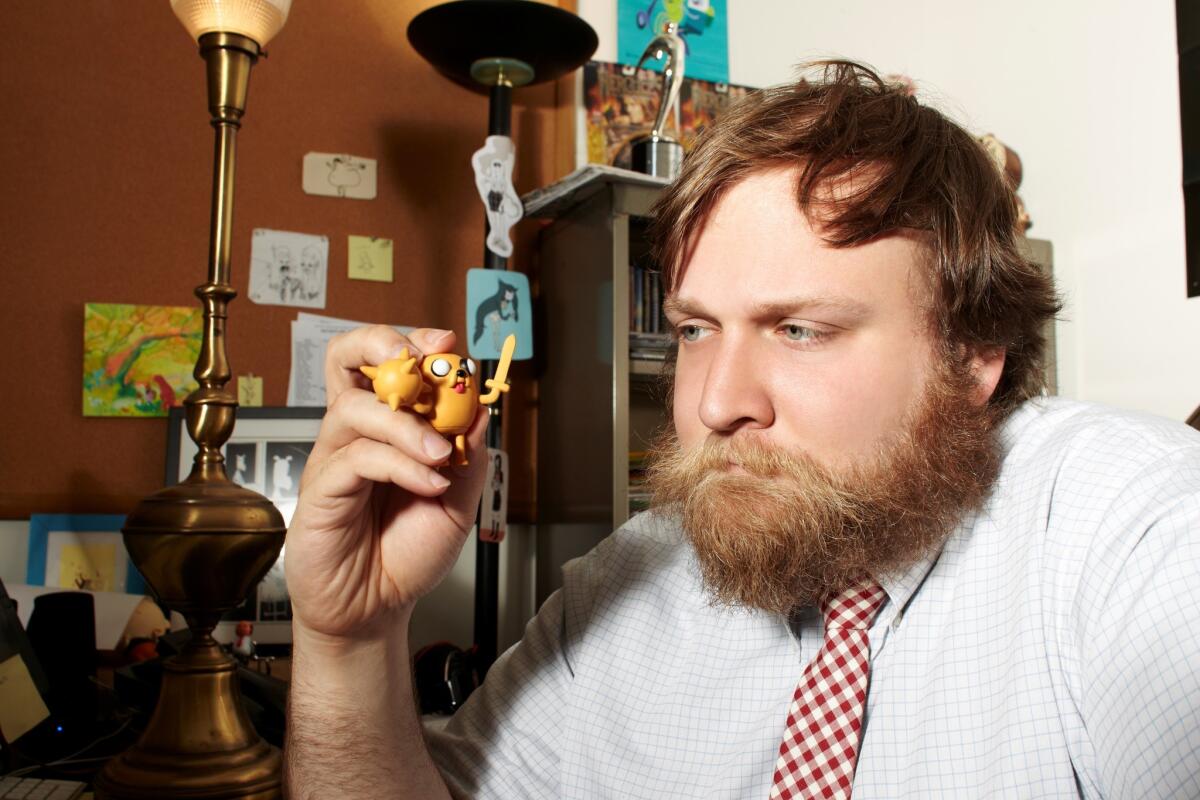
"Random! Cartoons" was a series of shorts produced for Nickelodeon by Frederator Studios, designed to field new talent and potential series. After leaving Cal Arts, Ward took his rejected minute, turned it into âa larger thingâ and pitched it again.
Fred Seibert (founder, Frederator Studios): He's standing there with a guitar; I have taken thousands of pitches, no one else has started a pitch singing. [Afterward] I said, "Well, weâre not doing that. Heâs a month out of school, we donât do student films, weâre not doing art films.â And Eric [Homan, Frederator vice president of development] said, âYou know, in most of these pitches you have a fake laugh and in this one you really laughed.â
A short is made, in which Finn (then called Pen) and Jake rescue Princess Bubblegum from the Ice King and Finn/Pen travels in his mind to Mars where Abraham Lincoln advises him to believe in himself.
McHale: I remember when Pen did the boards. When they came back from the animator, he was like, âItâs magic! You just do some drawings and then it becomes a cartoon! Itâs amazing!â
Seibert: My 11-year-old had announced he was never gonna see an animated movie again because all the stories were the same. So when I said âI have this cartoon Iâd love you to seeâ he just walked away. My 9-year-old sat patiently though it and when it was over said âThanks!â and walked away. Couple hours later, Iâm putting him to bed, I turn off his light, Iâm about to close the door and he whispers, âHey, Dad. What time is it?â And he puts his fist up.
Seibert has trouble finding "Adventure Time" a home but gets permission from Nickelodeon to put the pilot online, where it becomes a viral sensation.
Ward: It was really cool! Iâd never had anything like that happen to me. Itâs fun just as a social experiment to see how people react to this thing youâre making. I had put in lines I thought people would react to, made-up slang, like âMathematical! Rhombus!â It was actually way more fun to see people hate it -- like, "Who are you?"
âIt was actually way more fun to see people hate it â like, âWho are you?ââ
â Pen Ward, "Adventure Time" creator
Ian Jones-Quartey (storyboard supervisor, later creator of "OK K.O.: Letâs Be Heroes"): I was working on "Venture Bros." when the "Adventure Time" short came out, and I remember telling everybody I worked with, âGuys, this is the future.â And a lot of them who were maybe a generation older than me were like âWhat is this? I donât understand this at all.â
Rebecca Sugar (writer, storyboard artist, songwriter, later creator of âSteven Universeâ): I didnât understand it at the time. It was not anything like what I was interested in doing, but I thought people are going to love this. I just didnât know if I did.
Nick Jennings (art director): Everybody always says they loved it from the beginning, but most of the time thatâs not true. Pen was trying something new, and that newness is not always easy to understand.
Seibert: Over the next couple of years as we were trying to persuade first Nickelodeon, and then eventually Cartoon Network, the short would get taken down and then somebody else would bootleg it back up again. And every time I would re-pitch it, another few hundred thousand more views had been added. Finally I went to Cartoon Network and said, âLook, just ask your teenage kids, one of them has seen this. If they havenât, Iâll stop bothering you.â And sure enough one had.
Rob Sorcher (chief content officer, Cartoon Network): It was far from a sustainable television proposition, but I had not seen or felt anything like that in the genre before. It felt timeless, like a childrenâs classic book series. But at the same time there was this very contemporary overlay on it, in the way that it looked, in the way it moved, in the way it sounded.
The pilot becomes a series.
Seibert: We asked Pen, âSo what do you think this series is?â He said, âWell, I kind of think itâs like Archie and Betty and Veronica,â and the thing that was exciting about that was the first thing out of his mouth was not about anything but the relationship between the characters.
Adam Muto (writer, storyboard artist, creative director, eventually show runner): A lot of that early first season was âWe think the show is this. Maybe the network thinks itâs something else.â So even staffing up was difficult because we werenât in agreement about what the show was going to be.
Jennings: Pen was fairly new to animation. Also the people he was surrounding himself with were friends he had gone to school with so they didnât have much experience. I think I was partially brought in as an experienced person that could help guide the process. It was important I think to Pen and also the network to have some key people in positions to ensure the series would run as smoothly as it could. It was important to me to strike a balance between leaning on my experience and also being open to new ideas â I wanted to respect Penâs vision but also be there to ensure his vision was producible.
The background paintings by Dan Bandit, known as Ghostshrimp, help define the look of the show.
Seibert: I had loved the way that the pilot looked; Pen and Adam did everything. I see on the wall, a sample of one of the artists heâs hiring. I said âPen, is this really what you want to do?â He goes, âWhat do you mean?â I go, âWell, itâs so together, itâs so slick. Arenât you gonna do it like you did the short?â He said, âFred, I canât draw! I just did the best I could.â
Muto: The timing of Ghostshrimp coming on was really fortuitous. Because Pen and the art director -- Nick Jennings, at the time â were going back and forth about what it should even look like. Because we didnât want it to look exactly like the pilot, but should it look like a fantasy illustration?
Ward: He would draw an illustration of a forest and then in the background, heâd put a half-buried skeleton reading a book. Thatâs awesome, because youâre watching the story play on the cartoon in the foreground, but in the background thereâs a whole other story you can read into it. Thereâs a world that expands beyond the border of the television.
Sorcher: For every show, we do an art presentation once the team is up and going. And we went into a room and were surrounded on all sides by the Land of Ooo, the maps, the worlds, the characters. It had a dimensionality; it felt huge. It wasnât until that moment that I understood the size of the property.
A cast is assembled: Jeremy Shada as Finn and John DiMaggio, Bender on "Futurama," as Jake, with Hynden Walch (Princess Bubblegum), Olivia Olson (Marceline the Vampire Queen) and Tom Kenny (famously the voice of SpongeBob Squarepants, as the Ice King) rounding out the main roles.
Jeremy Shada (Finn the Human): My older brother, Zach, did the voice of Finn or Pen in when it was a "Random!" short for Nickelodeon. And when Cartoon Network picked it up I recognized the project; so I looked up the old short on YouTube and my voice sounded a ton like his was. I tweaked it a little to match it, auditioned and got the job. And the first day of recording nobody knew I was Zach's younger brother, they just thought they got lucky with someone that sounded like the original.
John DiMaggio (Jake the Dog): I was like, âI donât get this show." It was non sequitur, it was hard to follow the scripts. I felt I was in the dark about a lot of stuff and uncomfortable as an actor approaching the role. A couple of people kind of clued me in, like, you know, âGet over yourself, thisâll work.â Dee Bradley Baker thatâs in the show was, like, âDude, youâve gotta just gear up and do this thing and go home and cry in your bag of money." And then Tom Kenny said to me, âThis is this generationâs âYellow Submarineââ and I was, like, âAll right, let me let it go and follow that advice.â
Oliva Olson (Marceline the Vampire Queen): Pen Ward knew my dad, Martin Olson, who was writing for "Phineas and Ferb," and Pen randomly was like âMartin, thereâs this girl on âPhineas and Ferbâ who would be great for one of our voices. She plays Vanessa Doofenshmirtz. Do you know her?â And he was, like, âYouâre kidding, right?â
Shada: Someone had asked a question about me on a panel at Comic-Con; they were like, âOnce his voice changes, are you guys gonna replace him?â So I kind of looked over at Pen and Iâm thinking, âYeah, what is the deal?" And Pen was like âNo, no, no, weâre not replacing Jeremy. Heâs Finn, heâs our guy. If anything, Iâll just start maybe drawing him with a little gut hanging out or something."
Olson: Jeremy was 12 when we started, I was 17, so I was kind of in this weird in-between state of âDo I hang out with the adults, do I hang out with the kids?â We became really really close and I kind of looked after him like an older sister. And Marceline and Finnâs characters also sort of have that weird bond. Fans would ask, âDo Marceline and Finn ever date?â Absolutely not, thatâs not gonna happen, ever ever ever ever.
Shada: Finn ages, which was a really cool thing, because you have an audience of kids that can grow up with the show as Finn grows in real time. It starts off very black and white -- âOh thatâs evil, Iâm gonna punch it!â -- and as he goes through adolescence and teenagehood everythingâs not so cut and dried, right versus wrong all the time.
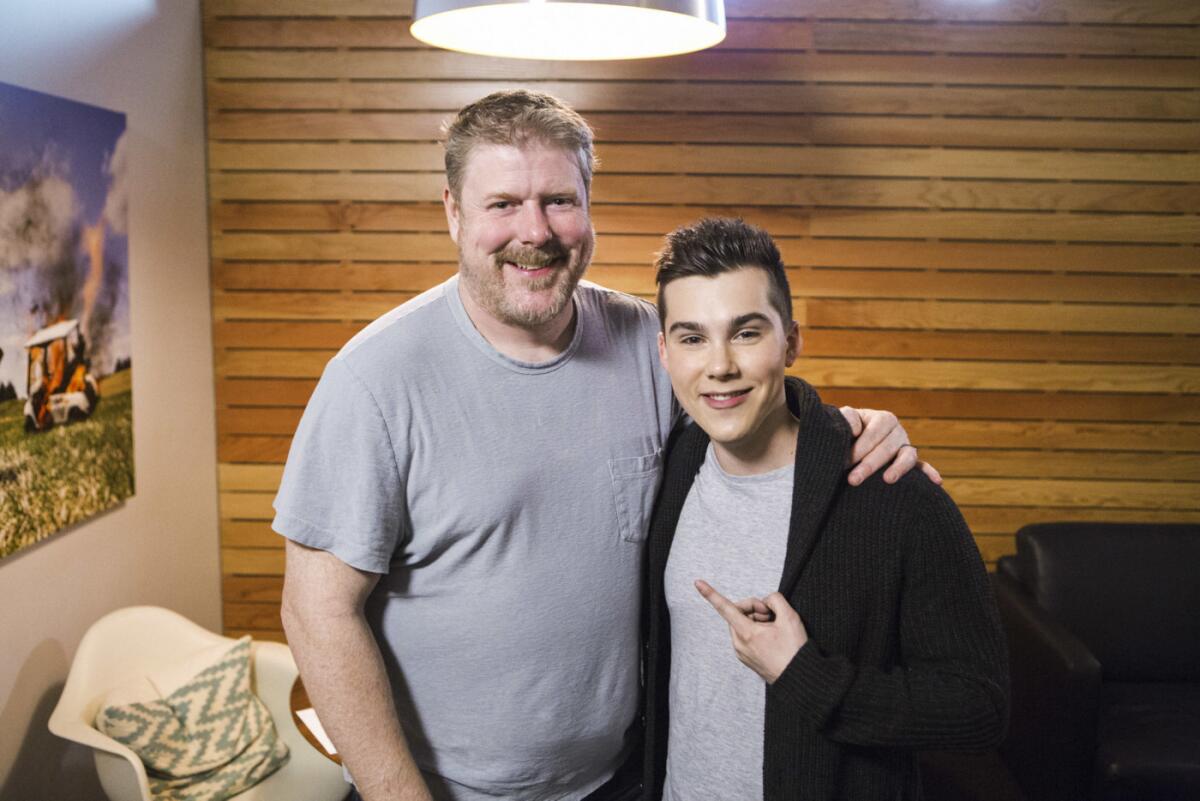
The show is âstoryboard-drivenâ â artists work from outlines that they flesh out with action and dialogue rather than from scripts.
Jones-Quartey: The storyboard artists are in charge of all the content. They create characters, they create environments. Itâs how all the Looney Tunes were made, all the great Disney cartoons, basically all the classic Hollywood cartoons. These were written by artists at the same time as they were drawing them.
Ward: I thought at first we were going to control it more with a script. I thought itâd take less time to write than to draw it. The first thing I wrote was âFinn and Jake make funny faces at each other." And that was the most boring thing.
Muto: In "The Prisoners of Love,â thereâs a scene with the Ice King carting Finn and Jake; heâs pushing them up a hill. And he takes a break and pulls out trail mix and eats it. And the slowness of it, and the calmness of it â you could put it in a script, like, âHe takes a break and eats trail mix,â and it would just get cut. But in a board, you can feel why it's right. It gives that heâs not just a pure villain, heâs a real guy and heâs just eating his trail mix, and he wants that last yogurt chip, he has to reach down and get it with his fingers.
Jones-Quartey: When I joined the show, there had been a lot of turnover and also the intent had changed a little bit. When they started, it was seen maybe as this action-adventure show. And by the time I joined, it seemed like a little bit of a slice of life comedy but with action-adventure elements.
Sugar: Early on I think there was a lot of pressure from the network to have sillier jokes and a louder show that would be more accessible to younger kids. There was an early version of the title sequence that was just this massive brawl. Everyone was trying to find what the show was. But it always knew what it was, which was the personal voices of the artists on staff.
Jones-Quartey: Pen would often set me loose and say, âCreate something special for this moment.â The first time you see Finnâs hair on the show, that was a scene that I storyboarded myself. In âMortal Folly,â where we finally get to see a great mushroom bomb, the way it turns into a huge mushroom cloud of skulls, that was something I created.
Seibert: The great thing about Pen is that he knows what he thinks works and what doesnât work but is open to any suggestions and any direction his team brings in. I have never seen anyone who can let go as much as Pen lets go while at the same time having absolute control of whatâs going on.
Sugar: I thought Iâd be doing independent comics that were personal and have a day job where I worked in animation, but it was gonna be two very different things. "Adventure Time" taught me immediately that everything I wanted to do with independent comics I needed to do for the show. So I was encouraged immediately to make everything smaller and subtler and realer, to make something that had a tone that was more true to my actual life. I had been almost afraid to do that in my own work.
Sorcher: I knew "Adventure Time" was successful in a new way when there were so many tumblr feeds featuring quotes from the show. Not the drawing, not the animation -- the writing.
âI was encouraged immediately to make everything smaller and subtler and realer, to make something that had a tone that was more true to my actual life.â
â Rebecca Sugar, "Adventure Time" writer, storyboard artist and songwriter
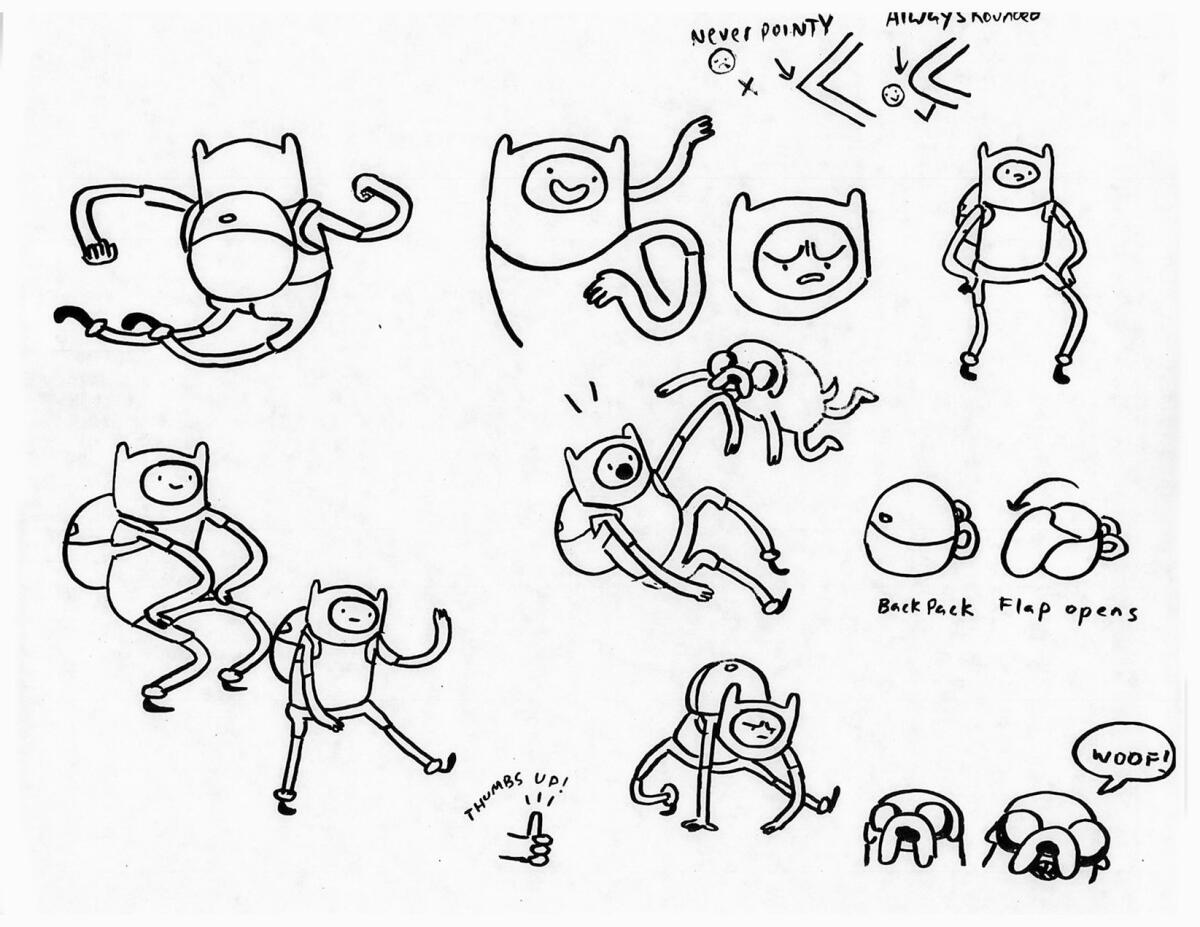
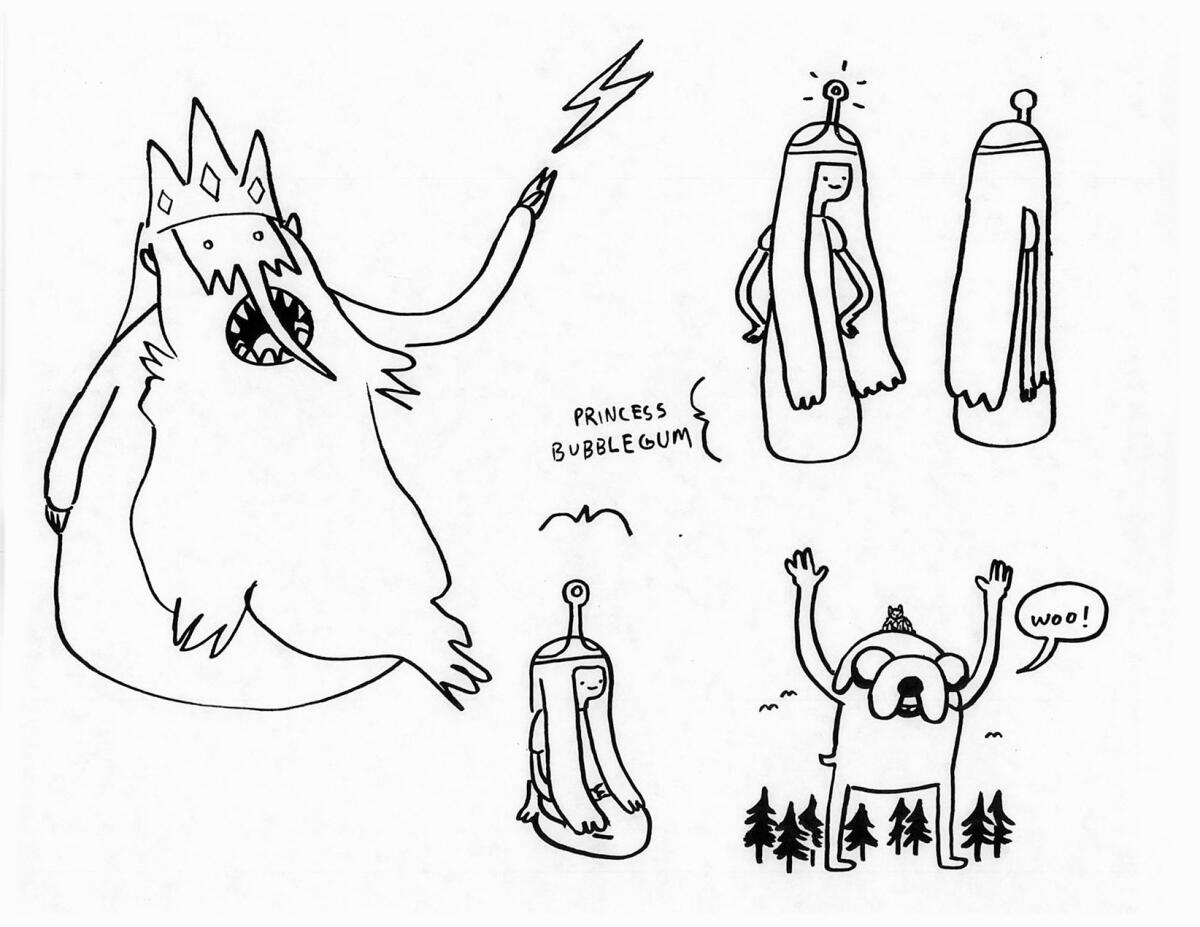
The series grows in viewership and influence. From 2013, the show wins at least one Emmy ever year. In 2015, it gets a Peabody award.
Seibert: By the time we went on the air, we already had 500 pieces of fan art. We not only had fan art, we had photographs of people who had sewn up their own Finn hats, just from this one short film.
Sorcher: It was, I think, the first animated series that a lot of the bits and pieces behind-the-scenes were shown online. Fred Seibert wanted to take the pieces that were happening at Cartoon Network studios and share them with an Internet audience. So I let them have all of it. Now I feel that thatâs one of the things that drove the fandom and helped to light those fires.
DiMaggio: After walking around at conventions and seeing everybody wearing their Finn costumes and their Jake costumes and how the characters endeared themselves to people was really the moment that, like, âOh. I get it now.â I see a family dressed up as characters form the show. They come to say hi and itâs just like, âWow!â That kind of put me in a different place.
Olson: A son and father came up to me at a convention. The kid tells me his dad has Alzheimerâs and the story arc between Marceline and the Ice King and the song âI Remember Youâ specifically helped him understand what his dad was going through. By the end, weâre all crying and hugging and talking about how this crazy show about wizard quests and fart jokes is helping this family stay together.
âBy the end, weâre all crying and hugging and talking about how this crazy show about wizard quests and fart jokes is helping this family stay together.â
â Olivia Olson, voice of Marceline the Vampire Queen
DiMaggio: I had no clue as to how big a worldwide success it would become. We were in the Thanksgiving Day Parade, floating down the street. I never imagined it, and how can you?
Shada: They had a bullet train in Taiwan that they painted all custom Jake on one half, Finn on the other half. We went to Australia to meet fans and a guy had done a mural on the side of his house that was the treehouse [where Finn and Jake reside] and all the different characters were on it. We went and got pictures outside of that, me and John. And the guy opened his window and peered down like, âHey what are you guys doing?â and weâre like, âHey itâs Finn and Jake, good morning, dude!â
Muto: We would see with characters what kind of response they got. I mean, we would basically just use whatever characters we liked, but if you saw that a character got a good reaction, you might be more tempted to use them. Not in an exploitative way.
McHale: And people would be like, âOh, I canât stand this character, why do they keep showing up?â
Muto: We have characters that are, like, super divisive. Tree Trunks is divisive, Lemongrab is divisive, but that doesnât mean we show them any less. But people love BMO; I would never not do a BMO episode just because BMOâs popular.
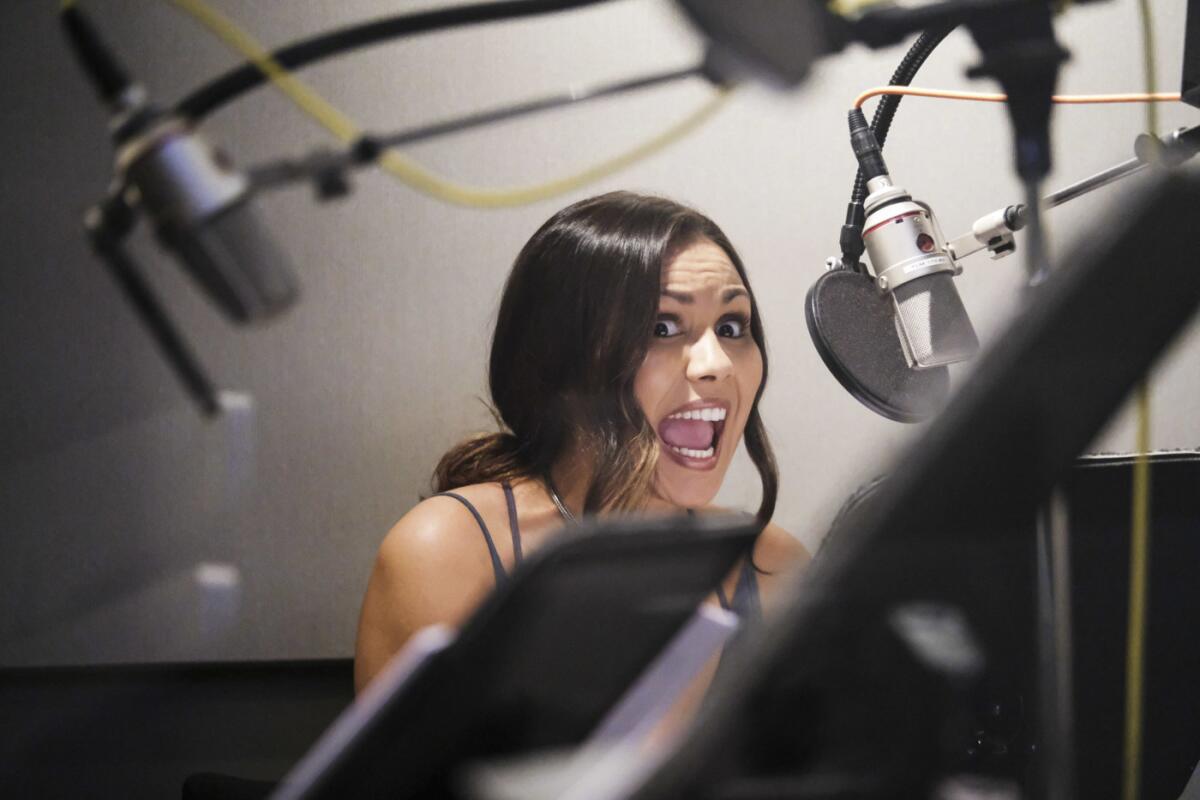
Halfway through season five, with no fanfare, Ward steps down as showrunner while continuing to work on the series and Adam Muto takes over.
Sorcher: Pen is highly intelligent, very, very thoughtful and empathetic and shy, shy -- and clearly a person who had never had to run an enterprise, which is what a television production is. It was also clear he wasnât sure if he really wanted to, which I completely respect, because he really is an artist.
Ward (on being asked about stepping down): I donât really want to talk about that. I donât know. Itâs not fun for me to reread the stuff that I blab out about that kind of thing.
As the seasons go on, the show experiments with form, including guest animators, stop-motion and miniseries. Drawings by character designer and storyboard revisionist Natasha Allegri (later the creator of âBee and Puppycatâ) lead to the gender-swapped âFionna and Cake.â
Sugar: Itâs a tradition I was familiar with as a fan artist.. When there was talk of turning it into an episode, I was eager to get to work on it. I pushed to make a story that had to do with the most basic themes of âAdventure Time,â because one episode would have to do for these characters what the entire run had done for the [others]. And by doing this one episode, you could see what all the other episodes would be if they were Fionna and Cake instead of Finn and Jake. I wanted to give you all the information you would need to translate every other episode into that.
Julia Pott comes to Cartoon Network to work on her pilot âSummer Camp Islandâ (now a series) and after a couple months is hired by âAdventure Timeâ as a writer.
Julia Pott: I had been a huge fan of âAdventure Timeâ since college, studying animation in England. It had a strange logic I loved and a gentleness to it, even though itâs, like, adventure and action. Itâs so relatable because itâs so specific. Everything just feels so considered. I think the first thing I wrote was the âElementsâ miniseries, so it was a lot to catch up on.
Sorcher: The show got more serial, it got a little bit darker, it went into more intense themes, and it did travel to a slightly different audience than when it started. But by then you had a group who had masterfully succeeded in producing something new. I felt they had earned the right to tell the stories they wanted to tell.
Pott: I felt very new, like I was walking into a high school in the last year. The first week in the writerâs room I didn't say anything because I was so nervous â âI shouldnât speak up, my idea is rubbish.â And then Adam had a meeting with me and was like, âWe did hire you to speak.â It taught me a lot about not getting your feelings hurt if your idea doesnât get used, and how an idea that maybe isnât the idea can spark someone elseâs brain working.
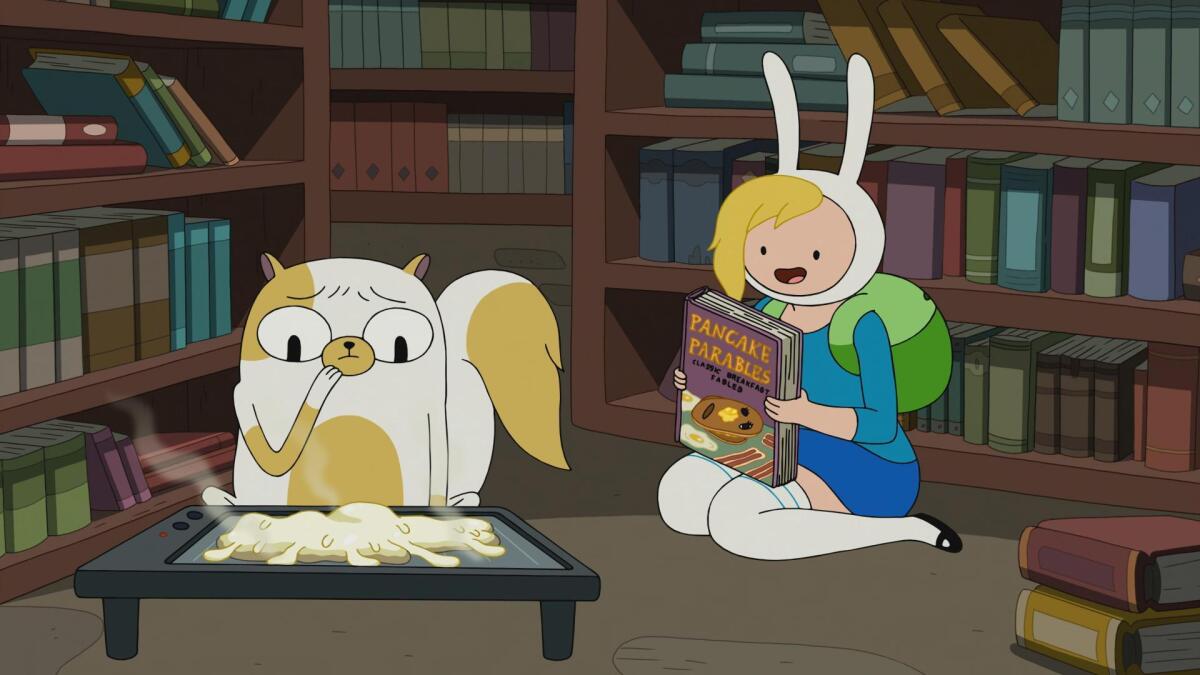
But all stories must end.
Sorcher: "Adventure Time" was playing less and less on Cartoon Network, yet we were moving towards a large volume of episodes. And I really began thinking âThis can't come quickly as a sudden company decision, it needs to be a conversation over a period of time.â And it did also strike me that if we donât wind this up soon, weâre going to have a generation of fans graduate through the demo and we wonât have completed a thought for them.
Muto: Anytime past season six we wouldnât have been surprised to be canceled because animated shows donât run that long on Cartoon Network. So we were already an anomaly. But it hadnât happened. So when it actually did happen it was like, âOh, my God, that canât happen!â
Ward: Youâre not necessarily prepared for it, so you have to go back and make sure the ending of the series isnât terrible.
Muto: When we picked the last episodes, I tried to make it so that a lot of them could function as the last episode for that character. Like this could be the last Tree Trunks episode, that could be the last Lemongrab episode.
Olson: Adam Muto had a really great way of putting it, that the ending of the show was getting stretched and stretched and stretched out because of how softly they let us know. There were definitely talks for a long time of âOkay, this might be last seasonâ and then it was âOkay, this is the last season.â And then âOkay, next week is gonna be the final episode.â
Shada: Definitely by the end of it, it was that bittersweet thing because you get so used to having your Tuesday afternoon recording âAdventure Time,â seeing your âset fam,â basically.
Muto: I freaked out a little because endings are so hard on TV shows. So it was like âWhat is the perfect ending?â That was a new kind of question. And I'm going to turn off my Twitter when the episode airs. I feel like we were able to have moments of what the show always was and things that were important to us that, regardless of reaction, I think will be satisfying to the people that made it.
Sugar: I wrote a song for the finale called âTime Adventure.â I wanted to write about how even if something ends, it continues to exist in the past, nothing ever really goes away, you only feel like it does because our mind has to process information one moment at a time in order for us to function as humans. Iâm so nostalgic for the time that I spent working on âAdventure Timeâ and I find it comforting to think that I still exist in that office with Adam, working on those stories. I would be so happy to come to work and brainstorm with him and sit down and draw on paper and pitch these stories with Post-its tacked up to the wall, just like they did in the 1930s with the stick and the song and the dance, the most traditional way of doing cartoons.
DiMaggio: The last day we recorded we had to do the final song that Rebecca Sugar wrote. I was a wreck when I first had to sing it and I was a wreck when I heard her sing it in front of 2,000 people at Comic-Con. Itâs just such a journey to go from being like, âI donât know what the hell this is about!â to sobbing and being, like, âThank you, Rebecca Sugar, for your beautiful music.â
Sugar: I feel so far away from it now, but I love that Iâm still there then. And I feel like that relates to animation as a concept, because you experience animation the way you experience time. You see one drawing at a time, you see them fly by and it creates this illusion that these characters are moving. You have to see it come and go in order to experience it. And I think that thatâs so much like life.
Follow Robert Lloyd on Twitter @LATimesTVLloyd
The complete guide to home viewing
Get Screen Gab for everything about the TV shows and streaming movies everyoneâs talking about.
You may occasionally receive promotional content from the Los Angeles Times.




